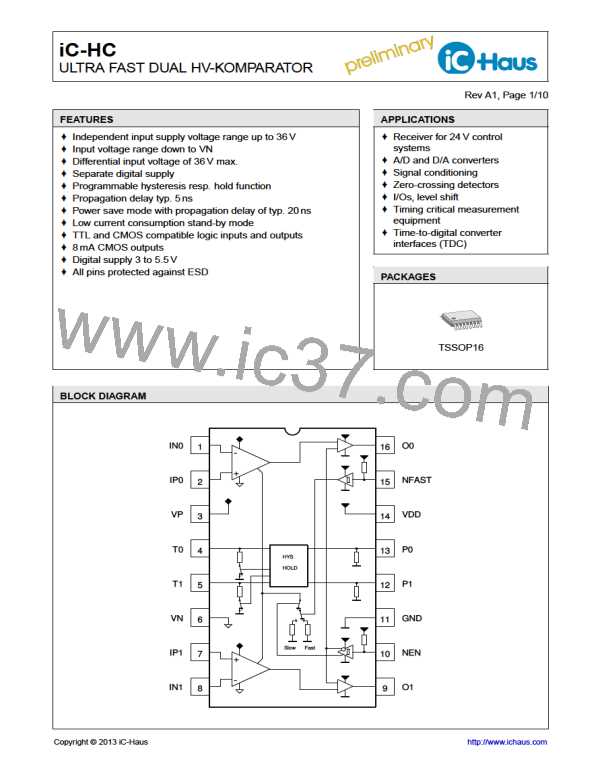iC-HC
ULTRA FAST DUAL HV-KOMPARATOR
Rev A1, Page 6/10
DESCRIPTION OF FUNCTION
VI(x)diff
For noise suppression four symmetrical hysteresis set-
tings can be configured as per Table 4.
time
time
VO(x)
P1 P0 T1
T0
0
1
0
1
0
1
0
1
Hys./Hold
no Hys./Hold
1 µs Hold
0
0
0
0
0
0
0
0
1
1
0
0
0
0
1
1
1
1
0
1
0
0
1
1
0
0
1
1
X
10 µs Hold
Figure 1: Switching characteristic without Hystere-
sis/Hold
100 µs Hold
±17 mV Hys.
±33 mV Hys.
±55 mV Hys.
±100 mV Hys.
no Hys./Hold
VO(x)hys
time
VI(x)diff
X
R/C∗ R/C∗ Hold with ext. R/C
+
Vhys
time
-
Table 4: Configuration
VO(x)hold
thold
thold
thold
thold
thold
time
Alternatively a hold function can be used for noise sup-
pression: Following each falling or rising edge at the
outputs the toggling is blocked for the configured hold
time. With the hold time elapsed the output will follow
the input signal instantly. Table 4 shows three pre-set
hold times. The hold function has the advantage over
the hysteresis, that it does not shift the input switch-
ing threshold. With the aid of the hold function even
extreme interferences like e.g. "bouncing" can be com-
pletely blanked. Figure 3 shows a respective example
of a zero-crossing detector.
Figure 2: Switching characteristic with hysteresis
resp. hold function
VI(x)diff
time
VO(x)
hysteresis too small,
no hold function
time
VO(x)hold
with hold function
Three hold times are pre-configured and can be cho-
sen according to Table 4 without external circuitry. For
different hold times external R/C networks can be used
at T0 and T1 (P0 and P1 = hi)). Both hold timers work
independently, so individual hold times can be chosen.
thold
thold
thold
thold
time
Figure 3: Blanking of noise using the hold function
∗ external R/C network

 ICHAUS [ IC-HAUS GMBH ]
ICHAUS [ IC-HAUS GMBH ]